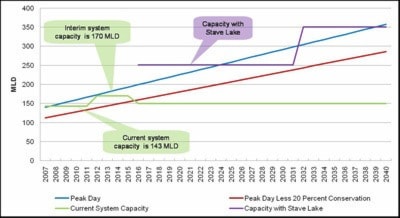Conservation is a key part of Abbotsford’s future water plans, but city officials maintain it will not be enough to meet consumer needs in the coming years.
According to the city, a new water source is needed by 2016 when, during peak periods, demand could exceed supply.
A proposed $291-million project to create a new water supply and treatment plant at Stave Lake north of Mission is the city’s preferred solution to the water issue. The project would include borrowing up to $230 million and entering into a public-private partnership (P3) to design, build, partially finance and operate the treatment centre. The city could receive up to $61 million in federal funding if the P3 plan is approved by voters.
Some critics of the new water supply believe a strict conservation approach could delay the need for a major water supply project. They point to a 2009 report created by POLIS (a centre at the University of Victoria which studies ecological governance). That study states that with an intensive approach to conservation – including sprinkling bans, tiered and increased water rates, rainwater catchments, low water use appliances – the city’s present water supply could be sufficient until 2031.
Tracy Kyle, the city’s director of water and solid waste, said the POLIS report was “theoretical” but did not solve the immediate problem.
“It didn’t consider the short-term needs.”
According to the POLIS study, the preferred scenario for the city was to make a “conservation commitment” which requires “a 45 per cent reduction in annual average daily water use by 2031.”
Kyle said the measures needed to achieve the POLIS goal “can’t be accomplished in a few short years” but rather over a 20-year period.
“People need time to change.”
Several conservation measures have already been implemented, but Kyle said, “we still don’t see the results.”
AECOM Canada Ltd., authors of the 2010 Abbotsford/Mission Water and Sewer Commission Master Plan, also concluded that the POLIS recommendations were unlikely to succeed.
AECOM noted “the Conservation Commitment approach requires a conservation ethic far beyond that of any major municipality in Canada or the United States. While the Conservation Commitment scenario is technically achievable, we question the practicality and public acceptance of this approach.”
So far, the city has managed to reduce daily consumption by about 10 per cent, well below the 45 per cent mark suggested by POLIS and only half the city’s current goal of 20 per cent.
Rainwater catchment systems have a good potential for success, considering the high amount of rainfall each year, but Kyle said the cost of the systems, coupled with Abbotsford’s current water rates, would mean it could take 15 to 20 years for people to recoup their investment.
“There’s not a lot of incentive for people to do it.”
Rainwater catchment systems are currently being used at the Abbotsford Entertainment and Sports Centre to create ice with recycled water, and the city works yard to fill watering trucks.
Abbotsford Mayor George Peary said the POLIS report was more of an “academic study,” and making it a reality would be a “challenge.
“If we could implement POLIS’ suggestions, 100 per cent, we may be able to delay our need for water a few years ... but I don’t think the public is ready to do everything in the report,” said Peary, citing the 2010 water sprinkling ban, which caused many lawns to go brown.
“I still have the scars from the lashes by the ladies in the garden club after our sprinkling restrictions.”
He said callers complaining about the ban called the measures “draconian.”
Carol Maas, one of the authors of the POLIS water report, said their findings were never meant to be a quick fix solution, rather a long-term strategy that would eventually allow the city to cut back water use by 45 per cent, over a period of more than 20 years.
But she says the lengthy timeline is no reason to abandon the approach.
“You don’t have to get to 45 per cent by 2016,” she said.
If the city can increase its conservation efforts slowly, at the same pace as its growth, then it is a viable option. Mass used Calgary as an example.
“Calgary is continuing to grow steadily, but its water use is flatlining.”
Simple to implement ideas, including allowing lawn sprinkling one day a week and changing building policies for new projects to include water conservation items (low flush toilets for example) can make a big difference.
“It makes sense to pick at the low hanging fruit to begin with,” said Mass.
